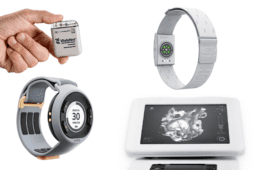Lowering internal eye pressure is currently the only way to treat glaucoma. A tiny eye implant developed by Stephen Quake’s lab could pair with a smartphone to improve the way doctors measure and lower a patient’s eye pressure.
For the 2.2 million Americans battling glaucoma, the main course of action for staving off blindness involves weekly visits to eye specialists who monitor – and control – increasing pressure within the eye.
Bioengineer Stephen Quake and collaborators have developed an eye implant that could help stave off blindness caused by glaucoma.
 Now, a tiny eye implant developed at Stanford could enable patients to take more frequent readings from the comfort of home. Daily or hourly measurements of eye pressure could help doctors tailor more effective treatment plans.
Now, a tiny eye implant developed at Stanford could enable patients to take more frequent readings from the comfort of home. Daily or hourly measurements of eye pressure could help doctors tailor more effective treatment plans.
Internal optic pressure (IOP) is the main risk factor associated with glaucoma, which is characterized by a continuous loss of specific retina cells and degradation of the optic nerve fiber. The mechanism linking IOP and the damage is not clear, but in most patients IOP levels correlate with the rate of damage.
Reducing IOP to normal or below-normal levels is currently the only treatment available for glaucoma. This requires repeated measurements of the patient’s IOP until the levels stabilize. The trick with this, though, is that the readings do not always tell the truth.
Like blood pressure, IOP can vary day-to-day and hour-to-hour; it can be affected by other medications, body posture or even a neck-tie that is knotted too tightly. If patients are tested on a low IOP day, the test can give a false impression of the severity of the disease and affect their treatment in a way that can ultimately lead to worse vision.
The new implant was developed as part of a collaboration between Stephen Quake, a professor of bioengineering and of applied physics at Stanford, and ophthalmologist Yossi Mandel of Bar-Ilan University in Israel. It consists of a small tube – one end is open to the fluids that fill the eye; the other end is capped with a small bulb filled with gas. As the IOP increases, intraocular fluid is pushed into the tube; the gas pushes back against this flow.
As IOP fluctuates, the meniscus – the barrier between the fluid and the gas – moves back and forth in the tube. Patients could use a custom smartphone app or a wearable technology, such as Google Glass, to snap a photo of the instrument at any time, providing a critical wealth of data that could steer treatment. For instance, in one previous study, researchers found that 24-hour IOP monitoring resulted in a change in treatment in up to 80 percent of patients.
The implant is currently designed to fit inside a standard intraocular lens prosthetic, which many glaucoma patients often get when they have cataract surgery, but the scientists are investigating ways to implant it on its own.
“For me, the charm of this is the simplicity of the device,” Quake said. “Glaucoma is a substantial issue in human health. It’s critical to catch things before they go off the rails, because once you go off, you can go blind. If patients could monitor themselves frequently, you might see an improvement in treatments.”
Remarkably, the implant won’t distort vision. When subjected to the vision test used by the U.S. Air Force, the device caused nearly no optical distortion, the researchers said.
Before they can test the device in humans, however, the scientists say they need to re-engineer the device with materials that will increase the life of the device inside the human eye. Because of the implant’s simple design, they expect this will be relatively achievable.
“I believe that only a few years are needed before clinical trials can be conducted,” said Mandel, head of the Ophthalmic Science and Engineering Laboratory at Bar-Ilan University, who collaborated on developing the implant.
The work, published in the current issue of Nature Medicine, was co-authored by Ismail E. Araci, a postdoctoral scholar in Quake’s lab, and Baolong Su, a technician in Quake’s lab and currently an undergraduate student at the University of California, Los Angeles.




